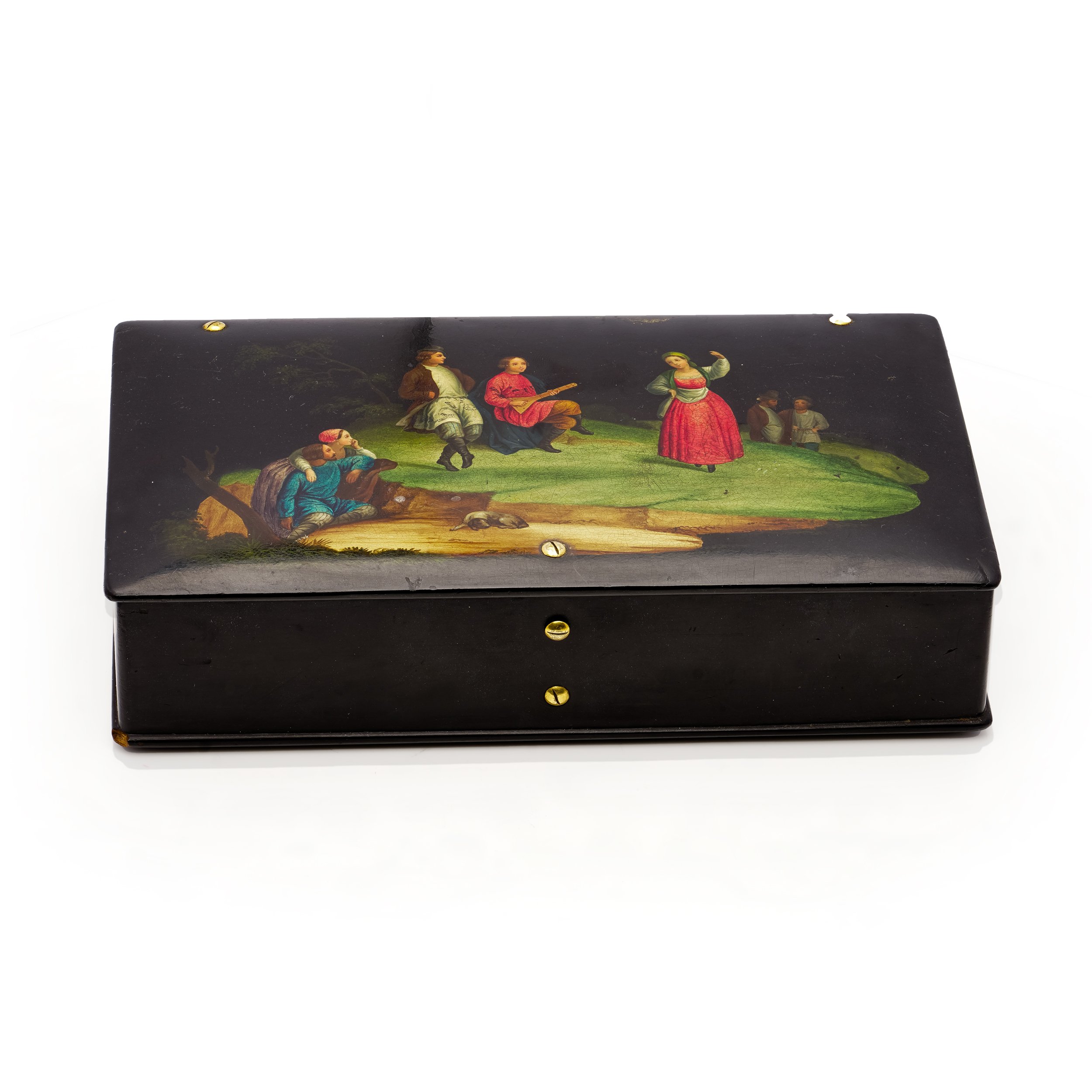SOLD OUT - Antique Russian paper-mâché lacquer box by Lukutin Factory
ITEM LOCATION : United Kingdom
SHIPPING FEE: Complimentary Express & Insured Shipping
INCLUDED: Complimentary Gift Wrap Packaging & Certificate of Evaluation.
RETURNS: 14-Days Return Policy, Money-Back Guarantee.
ITEM LOCATION : United Kingdom
SHIPPING FEE: Complimentary Express & Insured Shipping
INCLUDED: Complimentary Gift Wrap Packaging & Certificate of Evaluation.
RETURNS: 14-Days Return Policy, Money-Back Guarantee.
ITEM LOCATION : United Kingdom
SHIPPING FEE: Complimentary Express & Insured Shipping
INCLUDED: Complimentary Gift Wrap Packaging & Certificate of Evaluation.
RETURNS: 14-Days Return Policy, Money-Back Guarantee.
-
Antique Russian paper-mâché lacquer box, by Lukutins Brothers.
Made in Russia, Moscow c.1880's.
This box bears the inscription "Marked by Lukutins Brothers in Cyrillic under imperial warrant."
Dimensions:
Length x width x height: 20.3cm x 11.5cm x 4.7cm.
Weight: 367 gramsCondition: The box is pre-owned, minor signs of usage, one minor chip at the left corner, otherwise good and pleasant condition overall.
-
The label "Russian lacquer miniature," although clear to some, is not entirely descriptive to the newcomer. It contains several terms, yet omits a very important one. This omitted term refers to what they are constructed out of, namely papier-mâché. These articles are crafted using a special process and are moulded into boxes of every shape and size. The last term included in the catch-phrase title describes the size of the paintings that adorn them. The artists paint intricate compositions onto the lid and sometimes sides of these boxes, which can be as large as two feet square, to as small as one inch square. "Lacquer" refers not only to the special coating liquids that are used to seal the papier-mâché, and then the painting, but also to the articles themselves as a finished product. Finally, the first term, "Russian," is indicative of the unique style, history and tradition of this art form as it developed in four provincial towns of Russia. These towns are Fedoskino, Palekh, Mstera, and Kholuy.
In 1795, the Russian merchant Piotr Korobov visited the Braunschweig works and was introduced to a durable material that could be mass-produced and used to create cheap and simple articles.
Among the trends of the West that entered Russia was that of taking snuff. Although it was originally confined to the aristocracy due to its price, tobacco quickly became affordable. However, the boxes which held them continued to be made from costly materials, such as ivory, tortoiseshell, porcelain, and precious metals and gems. Amidst this demand for inexpensive, mass-produced snuffboxes, Korobov returned to Russia with materials and two craftsmen from the Braunschweig factory, and within a year opened the first papier-mâché factory in Russia in the village of Danilkovo, on the outskirts of Fedoskino, in the Moscow region.
In 1819, Korobov passed the factory to his son-in-law, Piotr Lukutin, who significantly expanded the workforce and elevated the level of artistry by providing grants for apprentices to attend the Stroganov school. This move resulted in a broader range of products that appealed to the upper, middle, and lower classes. The wealthy clientele could acquire cigarette cases, caskets, and other items adorned with genre scenes and landscapes on the lids, sometimes inlaid with mother-of-pearl, gold, or silver leaf. Meanwhile, merchants and townspeople had access to articles featuring reproductions of old masters and magazine illustrations.
As the popularity of snuffboxes declined, Lukutin shifted the focus to sewing boxes, tea caddies, trays, and other items. These pieces were decorated with scenes depicting troikas, tea parties, village festivals, and pastoral life. Lukutin ensured that his products were labeled with the mark "F. P. L.," representing the Factory of Piotr Lukutin. In 1828, he received the privilege of stamping his works with the state emblem, the double-headed eagle, symbolizing Russia.
The reputation of "Lukutinsky" productions spread throughout Russia, reaching their peak in popularity during the 1830s and 1840s. Alexander, Piotr's son, took over the factory in 1843 and continued his father's successful legacy. However, in the latter half of the nineteenth century, the demand for Lukutin articles declined. The Lukutin family's connection with the factory ceased in 1902 when the last of the Lukutins passed away, leading to the closure of the factory two years later.
Following this, the unemployed craftsmen of the factory joined forces with L. Derzhavina, a Fedoskino schoolteacher, to establish the Fedoskino Labor Artel of Former Employees of the Lukutin Factory. After reconstructing the workshop that had been damaged by vandals, they resumed their craft.












